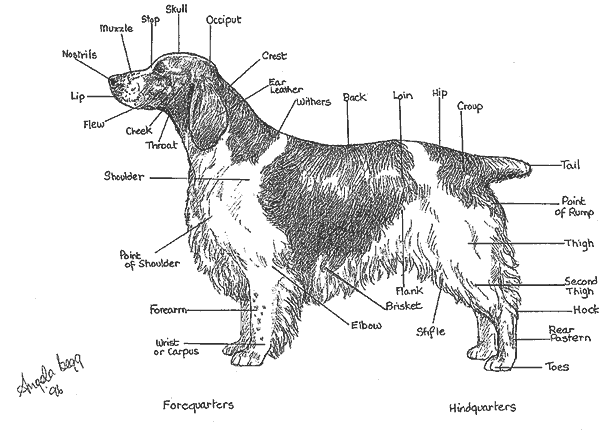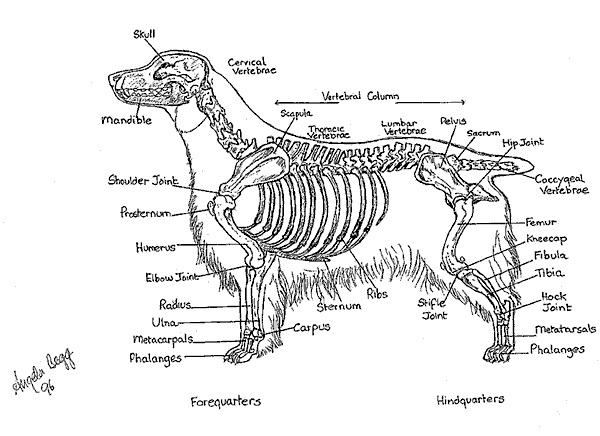About the Breed Standard
A Breed Standard is the guideline which describes the ideal characteristics, temperament, and appearance of a breed and ensures that the breed is fit for function. Absolute soundness is essential. Breeders and judges should at all times be careful to avoid obvious conditions or exaggerations which would be detrimental in any way to the health, welfare, or soundness of this breed. From time to time certain conditions or exaggerations may be considered to have the potential to affect dogs in some breeds adversely, and judges and breeders are requested to refer to the Kennel Club website for details of any such current issues. If a feature or quality is desirable it should only be present in the right measure,
It should be noted that the standards used by the AKC and FCI differ slightly from the UK one.
Drawings by Angela Begg, reproduced by kind permission of Andrew Begg.
The Kennel Club Breed Standard
Reproduced with permission from The Kennel Club.
A breed standard is the guideline which describes the ideal characteristics, temperament and appearance including the correct colour of a breed and ensures that the breed is fit for function. Absolute soundness is essential. Breeders and judges should at all times be careful to avoid obvious conditions or exaggerations which would be detrimental in any way to the health, welfare or soundness of this breed.
From time to time certain conditions or exaggerations may be considered to have the potential to affect dogs in some breeds adversely, and judges and breeders are requested to refer to the Breed Watch information related to this breed for details of any such current issues. If a feature or quality is desirable it should only be present in the right measure. However if a dog possesses a feature, characteristic or colour described as undesirable or highly undesirable, it is strongly recommended that it should not be rewarded in the show ring.
General appearance
Symmetrical, compact, not leggy, obviously built for endurance and hard work. Quick and active mover, displaying plenty of push and drive.
Characteristics
Very ancient and distinct breed of pure origin. Strong, merry and very active.
Temperament
Kindly disposition, not showing aggression or nervousness.
Head and skull
Skull of proportionate length, slightly domed, clearly defined stop, well chiselled below eyes. Muzzle of medium length, straight, fairly square. Nostrils well developed, flesh coloured to dark.
Eyes
Hazel or dark, medium size, not prominent, or sunken, or showing haw.
Ears
Set moderately low and hanging close to cheeks. Comparatively small and gradually narrowing towards tip and shaped somewhat like a vine leaf.
Mouth
Jaws strong with a perfect, regular and complete scissor bite, i.e. upper teeth closely overlapping lower teeth and set square to the jaws.
Neck
Long, muscular, clean in throat, neatly set into sloping shoulders.
Forequarters
Forelegs of medium length, straight, well boned.
Body
Not long. Strong and muscular. Deep brisket, well-sprung ribs. Length of body should be proportionate to length of leg. Loin muscular and slightly arched. Well coupled.
Hindquarters
Strong and muscular, wide and fully developed with deep second thighs. Hindlegs well boned, hocks well let down, stifles moderately angled, neither turning in nor out.
Feet
Round, with thick pads. Firm and cat-like, not large or spreading.
Tail
Previously customarily docked.
Docked: Well set on and low, never carried above level of back. Lively in action.
Undocked: Well set on and low, never carried above level of back. Lively in action. Feathered. In balance with the rest of the dog.
Gait/movement
Smooth, powerful, ground covering action; driving from rear.
Coat
Straight or flat, silky texture, dense, never wiry or wavy. Curly coat highly undesirable. Forelegs and hindlegs above hocks moderately feathered, ears and tail lightly feathered.
Colour
Rich red and white only.
Size
Approximate height: dogs: 48 cms (19 ins) at withers; bitches: 46 cms (18 ins) at withers.
Faults
Any departure from the foregoing points should be considered a fault and the seriousness with which the fault should be regarded should be in exact proportion to its degree and its effect upon the health and welfare of the dog and on the dog’s ability to perform its traditional work.
Note
Male animals should have two apparently normal testicles fully descended into the scrotum.



